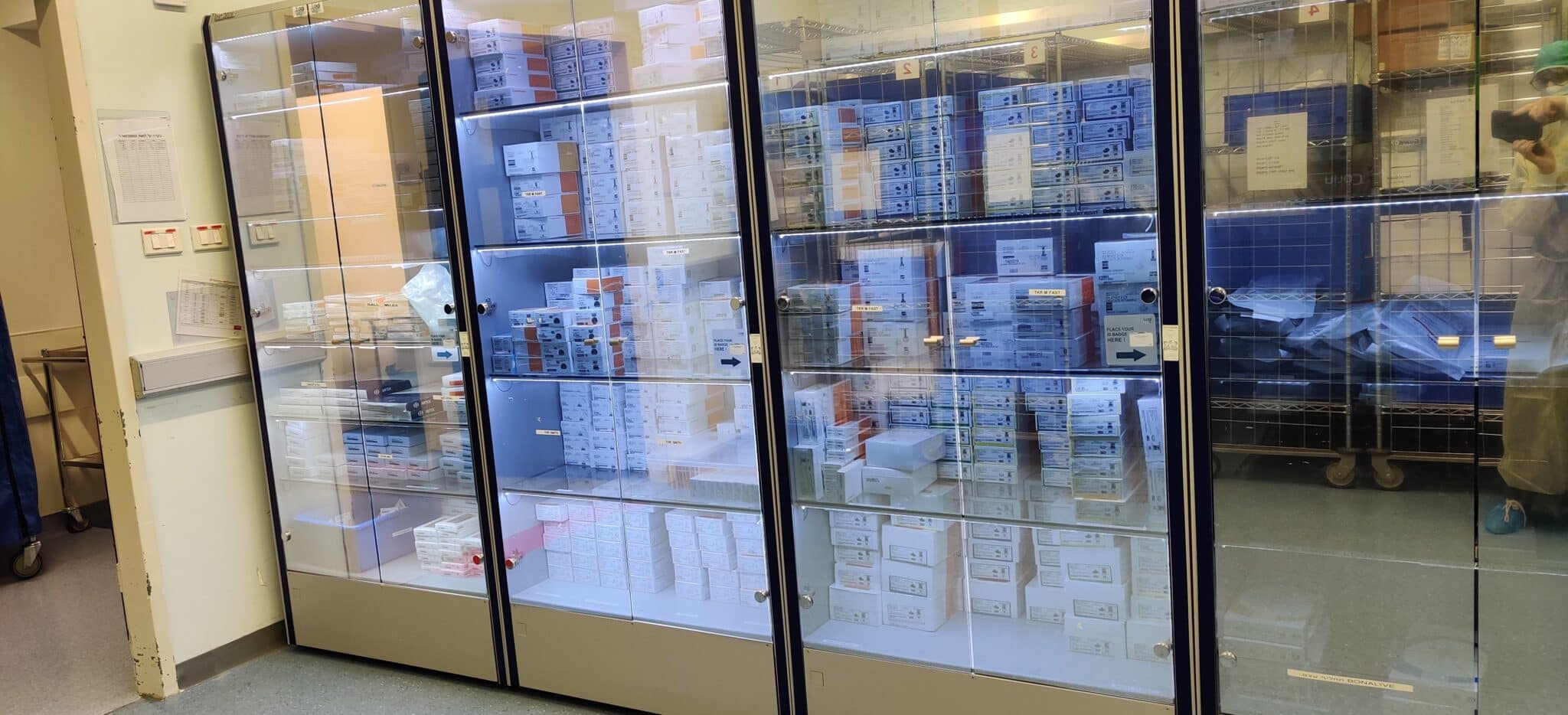What’s inside:
Managing orthopedic inventory is a difficult task and today’s video explores:
- The importance of OR utilization data
- 3 vital elements of a complete inventory management system for orthopedic stock
- Item level inventory tracking – in smart cabinets, in storerooms, and at the point of care
- Why hospitals fail to collect 100% usage data at the point of use.
- Best practice OR inventory management and the ROI of an effective automated solution
This is the first in a series of educational videos examining how to manage medical inventory in different settings.
This video is about managing orthopedic inventory.
Orthopedic inventory is particularly complex to manage in hospitals, health systems, and ambulatory surgery centers.
This video is an educational session on the challenges of orthopedic inventory tracking, looking at how to better manage medical devices and implants in the surgical setting – including non-sterile orthopedic implants.
We also look at the new technology that is providing a robust solution for end-to-end inventory tracking for owned stock and consignment, as well as for all items consumed at the point of care, including bill-only items.
Watch the video or scroll down to read more.
Do you prefer to read rather than watch?
You can browse through the video narration here:
Introduction to managing orthopedic inventory:
Welcome to our series of short educational presentations on managing medical inventory in different settings.
Today we look at the difficulties of managing inventory in the orthopedic setting and discuss why orthopedic supply chain management is so problematic. We’ll also look at new technology that is adding speed and accuracy to this task.
The challenges of managing orthopedic inventory in hospitals and ASCs
Let’s take a look at some of the reasons that managing orthopedic inventory is such a challenge.
Well, the most obvious reason is the sheer variety of inventory used in orthopedic procedures – this may include trunk stock, kits, and trays that require pre-sterilization, stock items, substitute items, last-minute deliveries, and consignment.
You can’t preselect orthopedic inventory as the physician may not know exactly which product, type, or size is best suited to the patient until the surgery is in progress.
Another key factor that makes orthopedic inventory management so hard to manage, is the fact that it’s all down to busy nurses, whose main priority needs to be patients, not products.
Orthopedic inventory management
Let’s dive a bit deeper into these challenges.
MANAGING ORTHOPEDIC INVENTORY:
With a large on-hand inventory, orthopedic nurses often struggle to manage expiry – which is often a manual task. Another common barrier is the limitations of product usage documentation systems, which fail to record the wide variety of orthopedic stock, sending nurses into longwinded, manual processes.
OPTIMIZING ORTHOPEDIC CASE REVENUE:
Barriers to optimized revenue include an out-of-date item master or chargemaster, inadequate point-of-use technology, and a reliance on manual data entry.
ORTHOPEDIC REIMBURSEMENT:
Incomplete or inaccurate surgical utilization data can affect revenue cycle management (RCM) and delay, or reduce, reimbursements.
BOOSTING PATIENT SAFETY IN ORTHOPEDIC SURGERIES:
Finally, the challenge of ensuring that the electronic health records EHR rea complete and correct by the end of surgery, while not getting distracted from patient care.
Why do current point-of-use utilization documentation systems fail
We can see that current systems, such as barcode scanning, QR codes, and manual keying in of data are not effective in the orthopedic setting, and cause nurses to spend significant time post-surgery accounting for supplies, while supervisors end up having to reconcile case charges in the system.
What’s needed is a solution that can achieve end-to-end tracking of every type of item – including achieving full item and charge capture at the point of care.
Complete inventory management solution for orthopedic inventory
The complete inventory management solution for the orthopedic department needs to achieve 3 things, the tracking of stock managed using RFID, the management of items that are not RFID tagged, and the reporting of them all.
IDENTI Medical has created the next generation of orthopedic inventory management using:
- Advanced data-sensing hardware
- AI cloud software that taps into a global SKU database and is fully interoperable with hospital systems.
RFID Smart Cabinet for Orthopedic Inventory
The first line of attack to achieve full OR data is item-level inventory tracking.
Total Sense is a UHF RFID smart cabinet that perpetually tracks every item and reports on inventory levels. The technology can be shared with partners such as vendors, distributors and GPOs making it ideal for pain-free consignment management as well as local owned-stock management.
The smart cabinet is secure and can track both user and item activity.
The cabinet can be ordered in different configurations, making it relevant for all departments, stock types and product sizes – and there are great options for orthopedic areas.

Virtual inventory management for products kept in storerooms
Inventory that’s not in the cabinet, but sits on the shelves, can also be tracked.
IDENTI’s Total Sense Mobile turns Orthopedic store rooms into a virtual smart cabinet.
Using RFID tags, a mobile scanner, and our AI cloud technology ensures comprehensive orthopedic stock management for items in the cabinet, or on the shelves.

Problems with existing barcode systems at the point of use
Currently, existing systems over-rely on busy nurses, are too barcode-dependent, are held back by clunky software, and are constrained by out-of-date item catalogs.
It’s time for an upgrade.
IDENTI’s documentation solution for the orthopedic department brings the barcode system of the product documentation era to an end and heralds in a brand-new way of capturing utilization data – by taking a snap of product packaging!
At IDENTI, we don’t scan we snap and go.
We understand the orthopedic environment and the time taken to record the nuts, bolts, and screws used in surgery, that’s why our system can ‘read’ hand-written implant sheets, making it easy to digitally record the small, loose items used in surgery.
So, let’s find out about Snap&Go.

Snap&Go is the ideal solution for orthopedic inventory management
Our next-generation point-of-use utilization documentation tool uses image recognition technology to turn item capture into a 3-second task!
It delivers automatic item identification via a globally-populated SKU database (supported by a human back office) ensuring that every item is identified, whether it finds a match in the local Item Master or not. Whether it’s a stock item or not. Whether it’s barcoded or not.
The AI platform produces metrics, reports, and data analytics to improve healthcare management and margins.
The importance of surgical data for healthcare management
Data is central to modern healthcare management. It’s the gas that feeds vital workflows and informs management decision-making.
Snap & Go delivers solid Orthopedic data that supports optimized revenue, a reduced, perpetual inventory, and enhanced patient safety.
ROI on a point-of-use perioperative documentation tech upgrade
Just look at the power of 100% data collection!
10 to 20% increase in reimbursement!
70% or higher reduction in hospital stock wastage!
30 to 40% reduction in nurse admin time
25% reduction in inventory
And more…
IDENTI has reimagined Orthopedic data collection giving you custom-designed data sensing tools, automated product identification via a global, virtual database, and vital Orthopedic utilization data to drive through efficiencies and improve organizational performance.
If you’re struggling with an inefficient inventory management system and inadequate point-of-use product usage documentation tool, it’s time to join the image-to-data revolution.






